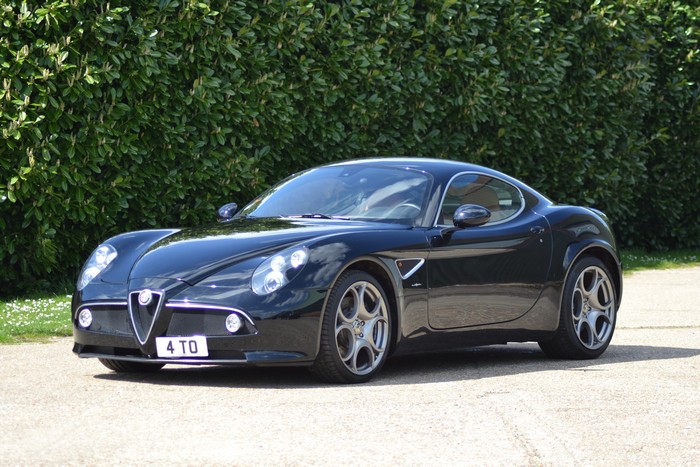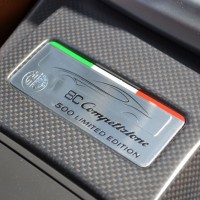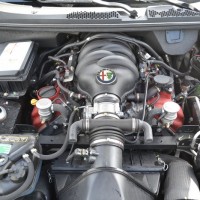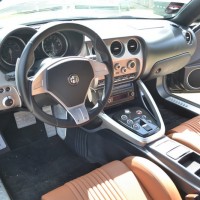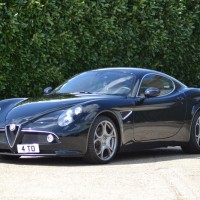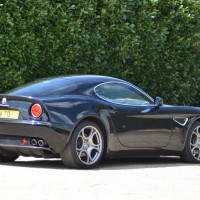SCM Analysis
Detailing
| Vehicle: | 2009 Alfa Romeo 8C Competizione Coupe |
| Number Produced: | 1,000 total, 50 of which were delivered to the U.S. |
| Original List Price: | $265,000 |
| Tune Up Cost: | $1,700 (annual service) |
| Chassis Number Location: | On top of dashboard at base of windshield on left |
| Engine Number Location: | Stamped on side of block |
| Club Info: | Alfa Romeo Owners Club |
| Website: | http://www.aroc-usa.org |
| Alternatives: | 2003 BMW Z8, 2009 Chevrolet Corvette ZR1, 2006 Ford GT, 2005 Mercedes-Benz SLR McLaren |
This car, Lot 345, sold for $135,431 (£90,000), including buyer’s premium, at Bonhams’ Goodwood Festival of Speed sale at Chichester, U.K., on July 12, 2013. (Sale held in GBPs, £1= $1.52.)
Whenever you see a profile in SCM on a car with a year of manufacture later than say, 1980, chances are we’ve strayed into the land of the “instant collectible,” “modern classic” or whatever you might call a limited-production, late-model vehicle of particular interest or notoriety. Often, such cars are heavily pre-ordered at dealers with hefty deposits, sold for multiples over their MSRP for months after introduction, and driven trace mileages before being parked in anticipation of instant profit.
Usually, the excitement wears off as the waiting list evaporates. Following a period akin to the “Phony War” of 1940 in Europe — when resale values are theoretical because no used cars come to the market — the reality of depreciation rears its ugly head, and some are left standing when the game of musical chairs stops. From the last convertible Cadillac Eldorado to the early-production Plymouth Prowler and the last VW Beetle convertible, the casualties of over-optimistic “investors” litter the used-car lots and late auction-lot lists of the world.
Then again…
On the other hand, there have been a handful of cars that really have defined the words “modern classic”— if not “instant collectible” — and enthusiasts of these automobiles regularly kick themselves for not timing the market exactly right to get them at the bottom of their accelerated and brief value lows. The byword for this is of course the McLaren F1, which was recognized at its launch as something extraordinary. Through its reputation on the road and the track, the F1 established itself as one of the high points of the 20th century automobile.
On a lower level stand the Ford GT and BMW Z8, two recent high-performance halo models that basked in pre-introduction hype and post-launch frenzy that abated into real-life depreciation — but with a curve back up into appreciation quickly enough to attract notice.
Is the Alfa Romeo 8C Competizione in this same company, or is it more akin to the Mercedes-Benz SLR McLaren, which has seen a more dramatic value decline with no bottom yet in sight?
I was fortunate to visit the Maserati factory in Modena when the 8C coupe was in production. It was fantastic to see them being built alongside their cousin — the Gran Turismo coupe — by a surprisingly young, attentive and enthusiastic work force. The carbon-fiber body panels and numerous lightweight and high-tech components contrasted wonderfully with the very traditional leather-wrapped cabin. The look of the car recalled the 33 Stradale, Giulia TZ and, to my eye, more than a bit of the Bertone “Canguro” show car of 1964.
A rise from ordinary Alfas
The 8C Competizione meant different things depending on where in the world you stood. For Europe, the U.K. and Japan, it was a dramatic halo model, soaring atop the other everyday Alfas on the showroom floor.
In 2007, Alfa dealers offered the 166 luxury sedan, the 159 sport sedan and wagon, the 147 compact 5- and 3-door hatchbacks, the Spider and two coupes, the 147-based GT and the 159-based Brera.
It was obvious that a judicious jaunt through the better areas of the Fiat Group parts bin could, with relative ease, result in a new range-topping car that would generate much-needed column inches of press to help move the more pedestrian metal. As a bonus, all this would simultaneously invoke the most glorious memories of the storied brand, when the pre-war 8-cylinder Alfas were the McLaren F1s of their day.
Carrot denied
To long-suffering U.S. Alfisti, the 8C was a dazzling carrot, held out to prove once and for all that talk of Alfa’s imminent return to our shores was more than an illusion. Alfisti hoped that not soon after the 8C, new Alfa sedans, coupes and roadsters would appear for the first time since 1995.
Not only that, but Alfa was going to come back with what would be the successor to the ultra-exotic Tipo 33 Stradale, that brilliantly conceived GT version of the 4-cam V8 Tipo 33 sports racing car. Only 18 examples of the 33 Stradale were built from 1967 to 1969, and the new 8C was to be limited to 500 copies worldwide.
That the anticipated full-line return didn’t happen during the run of the 8C Competizione Coupe (or Spider, for that matter) broke hearts, but so it goes.
Mild depreciation now
The MSRP of the 8C coupe in the U.S. in 2009 was $265,000. Miller Motorcars, a leading exotic-car dealer in Connecticut, delivered the very first 8C in America to SCMer Jim Glickenhaus, and has sold a good number of the U.S. allotment of 50 coupes during the run.
They have also sold a number of these Alfas as pre-owned examples and report that there is interest in the used-car market for the 8C, and when one does come up for sale it moves quickly.
The owners of these Alfas also do seem to be using their cars, although not as much as a contemporary Ferrari 458. They don’t seem to have been submerged in aspic, awaiting a new dawn.
Rising values ahead?
Looking at the comparison of the MSRP with a recent dealer sale is instructive when compared to the Bonhams transaction. In the U.S., a 2008 with 4,296 miles went for $215,000, which is 81% of the original U.S. list price. The Bonhams car, at £90,000 and approximately 6,000 miles, was exactly the same 81% of the (lower) U.K. MSRP.
For a four-year-old supercar, that’s not a bad residual value. To compare, a 2005 Mercedes-Benz SLR McLaren that listed for $450,000 was trading in the $300,000 range in 2009 as a four-year-old used car. That price was 67% of MSRP. By 2013, a 213-mile example sold for $225,500, which is now 50% off the original price.
Of course, there were also approximately 2,000 SLRs built compared with 1,000 8Cs, but we will have to see if the Alfa’s swing downward is near its end. It seems likely not to lose much more and could be an entertaining “investment.” But for heaven’s sake, drive it. ?
(Introductory description courtesy of Bonhams.)
